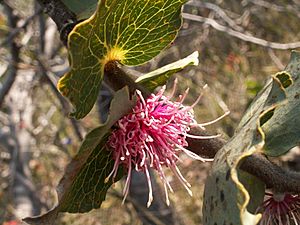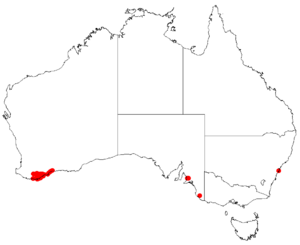Hood-leaved hakea facts for kids
Quick facts for kids Hood-leaved hakea |
|
|---|---|
 |
|
| H. cucullata in Waychinicup National Park. | |
| Scientific classification | |
| Genus: |
Hakea
|
| Species: |
cucullata
|
 |
|
| Occurrence data from Australasian Virtual Herbarium | |
| Synonyms | |
|
|
Hakea cucullata, also called hood-leaved hakea, cup hakea, or scallop hakea, is a type of shrub. It belongs to the plant family called Proteaceae. This plant grows only in the south-west part of Western Australia, meaning it is endemic there. It is a very pretty shrub with unique leaves and lovely, large, sweet-smelling flowers. These flowers can be pink, red, or deep purple.
Contents
What Does Hood-Leaved Hakea Look Like?
Hakea cucullata is a shrub that grows upright. It can reach a height of about 1 to 5 meters (3 to 16 feet). It usually has only a few branches. When the plant is young, its branches are covered with short hairs. The parts of the plant where flowers grow also have dark brown hairs.
Leaves of the Hood-Leaved Hakea
The leaves of this hakea are tough and feel like leather. They are shaped like a wide egg, about 37 to 75 millimeters (1.5 to 3 inches) long. They are also quite wide, measuring 38 to 90 millimeters (1.5 to 3.5 inches) across. Often, their edges are wavy or have small teeth. A clear vein runs down the middle of each leaf, ending in a point at the tip. The leaves are pale green. They often overlap each other and are distinctly cupped, wrapping around the stem, flowers, and fruit.
Flowers and Fruit of the Hood-Leaved Hakea
The flowers grow in clusters of 25 to 30 deep pink blooms. These clusters appear where the leaves meet the stem (called leaf axils) or on parts of the stem that have lost their leaves. Each flower cluster sits on bright pink stalks, which are about 5.5 to 8 millimeters (0.2 to 0.3 inches) long. The main part of the flower (called the perianth) is deep pink at the bottom and gets lighter towards the tip.
The small stalks that hold each individual flower (called pedicels) are 5.5 to 8 millimeters (0.2 to 0.3 inches) long and smooth. The part of the flower that receives pollen (the style) is smooth, straight, and 17 to 25 millimeters (0.7 to 1 inch) long. This plant mainly flowers from August to October. After flowering, it produces woody, egg-shaped fruits. These fruits are 2.2 to 2.8 centimeters (0.9 to 1.1 inches) long and 1.4 to 2.0 centimeters (0.6 to 0.8 inches) wide. They grow in groups of 1 to 5 in the leaf axils.
How Hood-Leaved Hakea Got Its Name
The plant Hakea cucullata was first officially described in 1830 by a botanist named Robert Brown. He studied a plant sample collected by William Baxter in 1824. Brown published his description in a book called Supplementum primum Prodromi florae Novae Hollandiae.
The second part of its scientific name, cucullata (which is the specific epithet), comes from the Latin word cucullatus. This Latin word means "hooded," which makes sense because of the plant's unique, cupped leaves that look like little hoods.
Where Does Hood-Leaved Hakea Grow?
The hood-leaved hakea is found in the south-western part of Western Australia. You can see it in places like the Stirling Range and east to the Whoogarup Range. It grows in specific areas known as the Esperance Plains, Jarrah Forest, and Warren biogeographic regions. These are different natural areas with similar climates and plants.
This hakea usually grows in sandy areas with mallee heath, which is a type of shrubland. Sometimes, it can also be found in gravelly soils that contain lateritic rock.
Is Hood-Leaved Hakea Endangered?
The Western Australian Government's Department of Parks and Wildlife has looked at Hakea cucullata. They have classified it as "not threatened." This means the plant is not currently in danger of disappearing.
Growing Hood-Leaved Hakea in Gardens
The scallop hakea is quite strong and can be grown in gardens. It has been successfully grown on Kangaroo Island. It's easy to grow new plants from its seeds. Gardeners have also successfully joined it onto the root system of another plant, Hakea salicifolia. This process is called grafting and can help the plant grow better in certain conditions.

